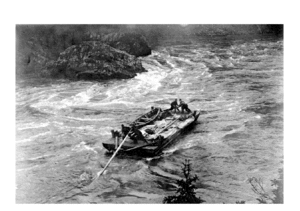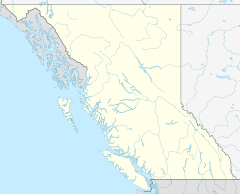Grand Canyon of the Fraser facts for kids
Quick facts for kids
Grand Canyon
|
|
|---|---|
| Country | Canada |
| Province | British Columbia |
The Grand Canyon of the Fraser is a short, impressive gorge on the Fraser River in central British Columbia, Canada. It's located about 30 kilometers (18.6 miles) upstream from where the Bowron River joins the Fraser. This spot is also about 100 kilometers (62 miles) east of downtown Prince George, British Columbia.
Right after the canyon, there's a part of the river called Scow Rapids. In the past, people used ropes from the riverbanks to pull boats and rafts upstream through these rapids. The canyon is found within the Sugarbowl-Grizzly Den Provincial Park and Protected Area, about 6 kilometers (3.7 miles) southwest of Hutton.
It's important not to confuse this canyon with the much larger and more famous Fraser Canyon. That one runs far to the south, from Williams Lake down to Hope.
History of the Canyon
The Grand Canyon of the Fraser was a very challenging part of the river to travel. It was located about 106 miles (170 kilometers) from Fort George by river.
In 1909, a special type of boat called the Nechacco became the first sternwheeler to successfully navigate this difficult canyon. This was a big achievement for river travel.
During 1912 and 1913, large boats called scows, used for railway construction, also managed to get through the canyon. To make it safer, skilled workers used 30 tons of dynamite in the summer of 1912. They removed some of the biggest rocks and obstacles from the steamboat channel. When the dynamite exploded, loud roars echoed through the canyon!
Even with these improvements, the river was still dangerous. Boats sometimes crashed, and people faced risks. Because of this, a portage was often used. This meant that goods were unloaded and carried around the most dangerous parts of the river.
From 1913, a police officer was stationed at the canyon. They made sure that each scow had a crew of eight men instead of the usual four. They also required any cargo over 15 tons to be taken off the scow and carried by portage. This helped make the journeys safer.
Supplies and Challenges
Throughout 1912 and 1913, a major construction company called Foley, Welch and Stewart (FW&S) had an important supply point at the canyon. This cache provided materials for the railway construction camps nearby.
Traveling the river was full of challenges:
- When the water was low, scows could get stuck on sandbars.
- In the spring of 1913, during high water, a powerful whirlpool pulled down and destroyed an FW&S scow. It was carrying a lot of valuable equipment, including steel cable and rails. Luckily, the crew made it to shore safely.
- Another time, a scow hit a rock, which knocked the steersman unconscious and sent a crew member, Mike Johnson, overboard. Johnson, who was a strong swimmer, managed to get back on board! They finished their trip without more problems.
The steamer B. C. Express also faced difficulties. On its first trip upriver that season, it needed three ropes to get through the canyon. But on the way back down, it managed to run through the canyon without any ropes or trouble.
Life at the Canyon
In September 1913, a man named Charles S. Sager even ran a barber shop and bathhouse from a large scow at the canyon! He later opened a bathhouse in Prince George in 1915. Even years later, in 1937, a canoe capsized below the canyon, showing that the river remained a place that required caution.



